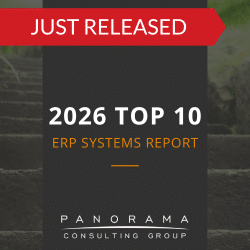If you’re beginning digital transformation or an ERP implementation, you’ll likely end up looking at the customer experience. The fact is that many of the processes and technology within an organization directly impact the customer experience, so today, we’re sharing tips on how to improve the customer journey as part of your technology initiative.
How to Improve the Customer Journey
1. Identify Customer Pain Points
Improving the customer journey starts with understanding customer needs and pain points. This is where a customer journey map comes in. This is a tool for identifying touchpoints and understanding customer behavior from the moment a customer becomes aware of a product or service to the post-purchase follow-up.
You will inevitably find pain points and opportunities to improve the customer experience. This might mean reducing wait times, streamlining processes, or providing better customer support.
In general, you want to remove barriers that might prevent customers from making a purchase. For example, you can optimize the checkout process by reducing the number of fields required to complete a purchase, offering guest checkout, and providing clear instructions.
Software Selection & Process Improvement Case Study
In helping the client get its project back on track, one of our primary focus areas was decreasing their customization needs by improving their processes to align with the system's best practices.
2. Measure and Analyze Customer KPIs
You can use customer feedback, surveys, and analytics tools to gather data on the customer journey, and use this data to identify opportunities for improvement.
As you track metrics like customer satisfaction scores, response times, and other key performance indicators, be on the lookout for slow response times, high customer churn, and low customer satisfaction scores. These present opportunities to redesign your existing business processes using business process reengineering.
3. Increase Data Visibility and Accuracy
If you’re currently lacking the customer data you need to make informed decisions about process improvements, then optimizing the data collection process is the best place to start.
First, determine what data you need, and then surmise what is getting in the way of obtaining reliable, real-time information. Manual processes and a lack of system integration are usually the major culprits.
4. Prioritize Personalization
To personalize the customer journey, you need to understand your customers. Start by gathering information about their past interactions with your brand, their interests, and preferences. You can use this information to provide personalized recommendations, tailored content, and customized messaging.
For example, you can deliver personalized messaging through automated communication, such as SMS and email, providing customers with real-time updates.
5. Provide Customer Self-Service Options
Process improvement often involves reducing the number of steps in a workflow to free up teams to focus on more complex issues. Consider providing self-service options, such as online help centers, knowledge bases, and chatbots, so you can free up your customer services teams.
For instance, you can implement a chatbot to provide real-time support and personalized recommendations based on customers’ previous interactions. Customer service teams can then spend more time analyzing the customer data generated by self-service portals and use it to improve products, services, and customer experiences.
6. Create Consistency
Consistency is key to creating trust and a positive customer journey. Customers expect a consistent experience across all touchpoints, from the first impression to the final purchase. Thus, it’s important to implement customer experience standards and invest in employee training.
6. Streamline Order Fulfillment
Customers should receive orders quickly and efficiently, so look for ways to streamline the packing and shipping process, or consider how you might use ERP software to automate order updates.
The right order management system can streamline many of the manual processes involved in order fulfillment, such as tracking inventory levels, processing orders, and sending shipping notifications.
8. Optimize Your Warehouse Operations
The efficiency of your warehouse operations can have a significant impact on the customer journey. Consider implementing a barcode scanning system to improve accuracy and reduce human error. You may also want to invest in automation, such as conveyor systems, to improve order picking and packing speed.
9. Give Customers Confidence That Their Data is Secure
Protecting customer data is crucial to building trust and maintaining long-term relationships. Ensure that you have appropriate security measures in place, such as encryption and secure storage, and make these practices clear to customers.
10. Ensure a Thorough Software Selection Process
When it comes to customer relationship management (CRM) systems, there are many vendors to choose from. The same is true of ERP systems, artificial intelligence technology, chatbots, and all digital technologies involved in the customer journey.
Blindly selecting a software vendor is a recipe for disaster. You must consider your company’s long-term IT strategy, business goals, and information strategy to determine what systems best meet your business requirements.
11. Continuously Improve the Customer Journey
To stay ahead of the competition, you must be able to meet changing customer expectations. This might mean implementing new technologies, improving existing processes, or exploring new channels for customer engagement.
For example, to increase customer engagement and foster a sense of community, you might create a community forum where customers can ask questions, share experiences, and provide feedback. This can help build trust and increase customer loyalty, as customers feel like they are part of a larger community of like-minded individuals.
Next Steps: Understanding Your Current Customer Experience
If your current customer experience is lackluster, you’re probably wondering how to improve the customer journey. Our business process reengineering consultants can help you reimagine your processes and technology to directly impact your customer metrics. Request a free consultation below to learn how to stay ahead of the competition, retain customers, and increase customer loyalty.














